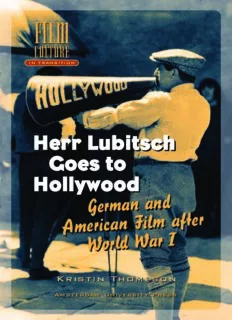
Herr Lubitsch Goes to Hollywood: German and American Film after World War I PDF
Preview Herr Lubitsch Goes to Hollywood: German and American Film after World War I
Ernst Lubitsch, the German film director who left FFIILLMM FFIILLMM Berlin for Hollywood in 1923, is best remembered for the famous “Lubitsch touch” in such masterpieces as H Trouble in Paradise and Ninotchka, featuring Greta E Garbo. Kristin Thompson’s study focuses on Lubitsch’s CCUULLTTUURREE R CCUULLTTUURREE R silent films from the years between 1918 and 1927, L tracing the impact this director had on consolidating IN TRANSITION U IN TRANSITION B classical Hollywood filmmaking. She gives a new I T assessment of the stylistic two-way traffic between S C the American and the German film industries, after H World War I each other’s strongest rival in Europe. G By 1919, Lubitsch had emerged as the finest pro- O ponent of the German studio style: E S sophisticated, urbane and thorough- T ly professionalized. He was quick to O absorb ‘American’ innovations and H stylistic traits, becoming the unique O L master of both systems and contrib- L Y uting to the golden ages of the Ame- W HHHHeeeerrrrrrrr LLLLuuuubbbbiiiittttsssscccchhhh rican as well as the German cinema. O O Utilizing Lubitsch’s silent films as a D key to two great national cinemas, GGGGooooeeeessss ttttoooo Thompson's extensively illustrated K and meticulously researched book R I goes beyond an authorial study and S T breaks new ground in cinema history. I HHHHoooollllllllyyyywwwwoooooooodddd N T Kristin Thompson is an honorary H fneilclaotwio ants tAhret sD aetp tahret mUennivte orsf iCtyo mof mWuis-consin, Madison. OM GGeerrmmaann aanndd P She is the author of Storytelling in Film and Television. S O N AAmmeerriiccaann FFiillmm aafftteerr WWoorrlldd WWaarr II ISBN90-5356-708-9 KKrriissttiinn TThhoommppssoonn 9 789053 567081 AAmmsstteerrddaamm UUnniivveerrssiittyy PPrreessss AAmmsstteerrddaamm UUnniivveerrssiittyy PPrreessss WWW.AUP.NL Herr Lubitsch Goes to Hollywood Herr Lubitsch Goes to Hollywood German and American Film after World War I Kristin Thompson Amsterdam University Press Coverphotograph:ErnstLubitschatworkonhisfirstHollywoodfilm,Rosita (courtesy the Academy of Motion Picture Arts and Sciences) Cover design: Kok Korpershoek, Amsterdam Lay-out:japes, Amsterdam isbn90 5356 709 7(hardcover) isbn90 5356 708 9(paperback) nur 674 © Amsterdam University Press, Amsterdam,2005 All rights reserved. Without limiting the rights under copyright reserved above,nopartofthisbookmaybereproduced,storedinorintroducedintoa retrievalsystem,ortransmitted,inanyformorbyanymeans(electronic,me- chanical,photocopying,recordingorotherwise)withoutthewrittenpermis- sion of both the copyright owner and the author of the book. For Paolo Contents Acknowledgements 9 Introduction Lubitsch: The Filmmakers’ Filmmaker 11 Lubitsch’s Place in Two National Cinemas 12 The Standard Story: Germany Escapes Hollywood’s Influence 14 Chapter One: Lubitsch’s Career Studying the Conditions of Influence 17 Lubitsch and the German Film Industry 19 Lubitsch’s Reputation in the 1920s 29 Areas of Stylistic Influence 31 Chapter Two: Making the Light Come from the Story: Lighting Different Lighting Equipment 35 Different Conceptions of Lighting 38 Lubitsch and the German Norm 42 Germany’s Discovery of Three-point Lighting 47 Lubitsch Masters Three-point Lighting in Hollywood 50 Three-point Lighting and Expressionism 52 Chapter Three: Subduing the Cluttered Background: Set Design Classical Norms of Set Design 53 Lubitsch and German Set Design 57 Herr Lubitsch Goes to Hollywood 63 Lubitsch’s Work with His Hollywood Art Directors 68 Chapter Four: Guiding the Viewer’s Attention: Editing Lubitsch the Editor 71 Editing in Postwar German Films 74 8 Kristin Thompson Lubitsch’s Hollywood Films 84 Chapter Five: Peeking at the Players: Acting The Survival of Pantomimic Acting in Post-War German Cinema 91 Lubitsch’s German Features 93 Lubitsch’s Hollywood Features 98 Chapter Six: Mutual Influences Equipping for Influence: The Modernization of German Studios 109 German Cinema Goes Hollywood 112 Contemporary Discussions of American-Style Techniques 113 Distinctively German Devices and Their Impact 118 Epilogue: The Lubitsch Touch 127 Notes 133 Filmography 145 Index 149 Acknowledgements This book traces its existence back to a wonderful conference hosted at the University of East Anglia in December of 1983 and organized by Thomas Elsaesser:“Space,Frame,Narrative:ErnstLubitsch,SilentCinema1916-26.”I amgratefultoThomasandthestaffofthatconferenceforhavingplantedthe seedthatled,muchlater,tothisbook.ThepaperthatIpresentedattheircon- ferencesatinafilefolderformanyyears,duringwhichIhavepursuedother projects that involved watching German films, including those by Lubitsch and also about 75 “ordinary” German films (i.e., not German Expressionist, notKammerspiel,notNeueSachlichkeit).MymainfocusofstudywasGerman Expressionism, to which movement Lubitsch did not belong. He seemed, however,tooimportant–andattractive–afiguretoignore.Hisfilmshaveso farbeenaccordedfarlessclosestudythantheydeserve.Eventually,italsobe- cameapparentthatLubitschcouldprovideawaytocomparenormativestyles inAmericanandGermanfilmsofthelastdecadeofthesilentera,forherewas afilmmakerwho,uniquely,wasamasterofbothnationalstylesandthedirec- tormosthighlyrespectedbyhiscolleaguesinbothcountries.Mygratitudeto Thomascontinues,forthisexaminationofLubitschhascomefullcircleandre- turnedtohisdiligentcareinthefinalpublication.Mythankstohimandtothe UniversityofAmsterdamPressformakingitpossibletopresentthisanalytical study with the numerous illustrations that it required. IamgratefulforthevitalassistanceIreceivedduringmyresearchfromvar- iouspeopleandinstitutions:KitteVinkeandthestaffoftheDeutschesFilm- institut-DIF, Frankfurt am Main; Klaus Volkmer of the Münchener Film- museum; Gabrielle Claes and the staff of the Cinémathèque Royale de Belgique;PaoloCherchiUsai,CarolineYeager,andthestaffoftheMotionPic- tureDepartmentoftheInternationalMuseumofPhotographyattheGeorge Eastman House; Matti Lukkarila, Timo Matoniemi, and the staff of the SuomenElokuva-Arkisto,Helsinki;thestaffoftheMargaretHerrickLibrary oftheAcademyofMotionPictureArtsandSciences;andthedevotedorganiz- ers of La Giornate del Cinema Muto, Pordenone and Sacile, Italy. ConsiderablethanksareduetoPetervonBaghandMichaelCampiforpro- vidinginvaluableresearchmaterials.BenBrewster,LeaJacobs,andthefaculty andstudentsoftheweeklyColloquiummeetingoftheDept.ofCommunica- tionArtsattheUniversityofWisconsin-Madison,haveovertheyearsoffered
Description: